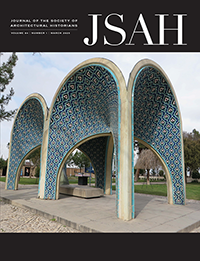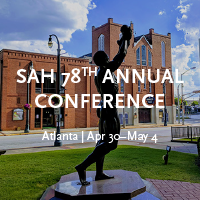As an affiliated society with the College Art Association (CAA), the Society of Architectural Historians is able to sponsor a session at CAA Annual Conferences. Luis M. Castañeda and Patricio del Real are co-chairing the SAH-sponsored session of the 2015 CAA Annual Conference, titled "Expanding the Modern Debate: Architects’ Writings in Latin America." (See full description below.) The 2015 CAA conference takes place February 11-14 in New York City.
Deadline to submit: June 15
Email your abstract (under 300 words) to the session co-chairs listed below.
Session Co-chairs:
Luis M. Castañeda
Assistant Professor of Art History
Department of Art and Music Histories
Syracuse University 308 Bowne Hall
Syracuse, NY 13244-1200
315-443-4875
email: lmcastan@syr.edu
Patricio del Real
Curatorial Assistant Department of Architecture & Design
The Museum of Modern Art
11 W. 53rd St. New York , NY 10019
t. 212-708-9545 f. 212-708-9419
email: patricio_delreal@moma.org
Session Description:
Manifestos, polemical tracts, architect’s books and theoretical essays have long been considered central artifacts in the study of twentieth-century architecture and design. As they were in multiple other contexts, writings of these and many other kinds were integral to the practice of architects and designers active in centers of architectural production in twentieth-century Latin America. The writings of some of the most canonical figures active in some of these contexts, like Lúcio Costa and Luis Barragán, only some of which have been translated into English, have begun to receive scholarly attention in recent years. However, the vast majority of architectural writings produced in conjunction with key episodes in architectural and urbanistic production in this vast and diverse region, many of which are fundamental components of the transnational histories of modern architecture, planning and design, still remain marginal to the purview of most studies.
This session invites proposals that examine the multiple ways in which writings by architects, planners and designers based in Latin America participated in significant cultural, historical, and political transformations. Some of these texts, for instance, took center stage in fundamental social, political and economic debates that transcended the boundaries of these disciplinary realms in light of the profound interrelation between modernist architectural production and the practices of government in many Latin American contexts. In some cases, like those of Peru-born architect Fernando Belaúnde’s two periods of presidential rule (1963-1968 and 1980-1985), architects’ and planners’ direct participation in state apparatuses blurred the boundaries between technical expertise and political action. In other cases, like the many scenarios of countercultural and dissent operations where architects were centrally involved, architectural and design writings became central aspects of oppositional practices.
Architectural writings are also closely interrelated with broader histories of Latin American avant-garde thought and practice. This, for instance, is the case of writings produced by figures like the Chilean-born painter Roberto Matta, trained as an architect, or the Uruguayan-born Joaquín Torres García, whose contributions are as highly significant to the development of twentieth-century painting and sculpture as they are to urban and architectural debates during the early decades of the twentieth century. Other figures like the German-born, and Caracas-based Gertrude Goldschmitt, or Gego, also trained as an architect, wrote compellingly about architectural and urban questions while crafting a sculptural practice that engaged architectural and urban space.
This session invites proposals that examine architectural and design writings in similarly expansive ways and highlight the multiple histories to which they belong. It especially invites contributions that highlight the intellectual production of figures positioned in understudied areas of architectural production in the Americas and by underrepresented groups.


